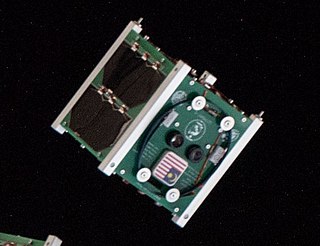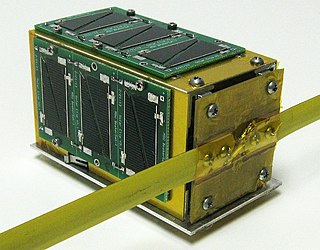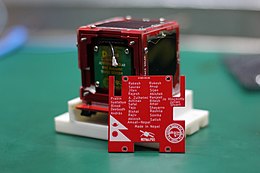AMSAT is a name for various amateur radio satellite organizations worldwide. In particular, it often refers to the Radio Amateur Satellite Corporation, headquartered in Washington, D.C. AMSAT organizations design, build, arrange launches for, and then operate (command) satellites carrying amateur radio payloads, including the OSCAR series of satellites. Other informally affiliated national organizations exist, such as AMSAT Germany (AMSAT-DL) and AMSAT Japan (JAMSAT).

A small satellite, miniaturized satellite, or smallsat is a satellite of low mass and size, usually under 1,200 kg (2,600 lb). While all such satellites can be referred to as "small", different classifications are used to categorize them based on mass. Satellites can be built small to reduce the large economic cost of launch vehicles and the costs associated with construction. Miniature satellites, especially in large numbers, may be more useful than fewer, larger ones for some purposes – for example, gathering of scientific data and radio relay. Technical challenges in the construction of small satellites may include the lack of sufficient power storage or of room for a propulsion system.
The Multi-Application Survivable Tether (MAST) experiment was an in-space investigation designed to use CubeSat spacecraft connected by tethers to better understand the survivability of tethers in space. It was launched as a secondary payload on a Dnepr rocket on 17 April 2007 into a 98°, 647 x 782 km orbit. The MAST payload incorporated three picosatellites, named "Ralph," "Ted," and "Gadget," which were intended to separate and deploy a 1 km (0.62 mi) tether. The experiment hardware was designed under a NASA Small Business Technology Transfer (STTR) collaboration between Tethers Unlimited, Inc. (TUI) and Stanford University, with TUI developing the tether, tether deployer, tether inspection subsystem, satellite avionics, and software, and Stanford students developing the satellite structures and assisting with the avionics design.
AeroCube-3 is a single-unit CubeSat which was built and is being operated by The Aerospace Corporation, at El Segundo, California. It is the third AeroCube picosatellite, following on from AeroCube-1, which was lost in a launch failure in 2006, and AeroCube-2 which was successfully launched in 2007 but failed immediately after launch. Compared to its predecessors it contains several improvements in its infrastructure, including a redesigned power system, replacing the older system which was responsible for the loss of AeroCube-2. Its development was funded by the United States Air Force Space and Missile Systems Center, at Los Angeles Air Force Base.

DRAGONSat is a pair of nanosatellites that will be demonstrating autonomous rendezvous and docking (ARD) in low Earth orbit (LEO) for NASA. It will be gathering flight data with a global positioning system (GPS) receiver strictly designed for space applications to gather flight data in the space environment. ARD is the capability of two independent spacecraft to rendezvous in orbit and dock without crew intervention. One DRAGONSat was built by the University of Texas and the other one was built by Texas A and M University, the Space Shuttle Payload Launcher (SSPL), These satellite projects will rendezvous and dock with each other in space without the benefit of human intervention.
STUDSAT, is a CubeSat satellite designed by students. This project was conceptualised and project managed by undergraduate students across India. STUDSAT is a picosatellite successfully launched on 12 July 2010 from Satish Dhawan Space Centre into a Sun-synchronous orbit. The mission's objective was for students to have a hands-on experience with the design, fabrication and realisation of a space mission at a minimum cost. Experimental in nature, the mission life was stated to be six months.
ITUpSAT1, short for Istanbul Technical University picoSatellite-1, is a single CubeSat built by the Faculty of Aeronautics and Astronautics at the Istanbul Technical University. It was launched on 23 September 2009 atop a PSLV-C14 satellite launch vehicle from Satish Dhawan Space Centre, Sriharikota, Andhra Pradesh in India, and became the first Turkish university satellite to orbit the Earth. It was expected to have a minimum of six-month life term, but it is still functioning for over two years. It is a picosatellite with side lengths of 10 centimetres (3.9 in) and a mass of 0.990 kilograms (2.18 lb).
AMSAT-OSCAR 16, also known as AO-16 and PACSAT, is the in-orbit name designation of an amateur radio satellite of the OSCAR series. It was built by AMSAT and was launched on 22 January 1990 from Kourou, French Guiana on an Ariane 4 launch vehicle. It is in Sun synchronous low Earth orbit.
An amateur radio satellite is an artificial satellite built and used by amateur radio operators. It forms part of the Amateur-satellite service. These satellites use amateur radio frequency allocations to facilitate communication between amateur radio stations.
A PocketQube is a type of miniaturized satellite for space research that usually has a size of cube with 5 cm sides, has a mass of no more than 250 grams, and typically uses commercial off-the-shelf components for its electronics.

Swayam is a 1-U picosatellite (CubeSat) developed by the undergraduate students of College of Engineering, Pune. They have successfully completed assembly of the flight model having a size of 1-U and weight of 990 grams under the guidance of Indian Space Research Organisation (ISRO) in January 2015. The structural design of the satellite, design of its electronic and control systems as well as the manufacturing of the satellite was carried out by the students. The project was completed over a span of 8 years and more than 200 students worked on it. The Satellite was launched by ISRO on June 22, 2016, along with Cartosat-2C by Polar Satellite Launch Vehicle C-34 from the second launch pad at Satish Dhawan Space Center, Sriharikota, India. The satellite is to be placed in low Earth orbit (LEO) around Earth at a height of 515 km.

ÑuSat satellite series, is a series of Argentinean commercial Earth observation satellites. They form the Aleph-1 constellation, which is designed, built and operated by Satellogic.

PicoDragon is a small satellite that followed the 1U type of CubeSat program built by the Vietnam National Satellite Center (VNSC) which belongs to VAST and operated in space for 3 months.

GhanaSat-1 was the first Ghanaian nanosatellite to be launched into space. It was designed and built in two years in conjunction with the Kyushu Institute of Technology Birds-1 program, which has the goal of helping countries build their first satellite.

Birds-1 was the first iteration of a multinational program called the Joint Global Multi-Nations Birds Satellite project, or Birds project, to help countries build their first satellite. The Japanese Kyushu Institute of Technology (KIT) supported the design and fabrication of the satellites. The constellation was launched by a Falcon 9 rocket to the International Space Station on 3 June 2017, as part of CRS-11, where it was released from the Kibō module into space. Japan, Ghana, Mongolia, Nigeria, and Bangladesh participated in the Birds-1 program, all building identical satellites for the constellation.
IRVINE02 is an educational 1U CubeSat mission that gives high school students the experience of building, testing, and controlling a nano-satellite to develop interest and talent in the science and engineering fields. The mission features the second orbital ion electrospray thruster developed by Accion Systems. Beyond the thruster, IRVINE02 utilizes magnetorquers, deployable solar arrays, a GPS unit, and a miniaturized 1.4 Watt blue laser communication module to transmit pictures and data back to Earth. The magnetorquers and the laser are both developed by the Ecuadorian Space Agency. This laser made IRVINE02 the first 1U cubesat to fly with an orbit-to-ground laser communications device. It transmits data and pictures to the Earth much faster than radio.

Birds-2 is the second iteration of a multinational program called the Joint Global Multi-Nations Birds Satellite project, or Birds project, to help countries build their first satellite. The Japanese Kyushu Institute of Technology (KIT) supported the design and fabrication of the satellites. The satellites were launched by the Falcon 9 Full Thrust rocket as a part of the SpaceX CRS-15 mission on 29 June 2018. The satellites were released from the Kibō module of the International Space Station (ISS) in August 2018.

$50SAT is an American amateur radio communications satellite. It was launched on November 21, 2013, with a Dnepr launch vehicle from the Dombarovsky Air Base, in Orenburg, Russia. It was part of the UNISAT-5 satellite program by GAUSS.
Swarm Technologies, Inc. is a company building a low Earth orbit satellite constellation for communications with Internet of things (IoT) devices using a store and forward design. Social Capital partners Jay Zaveri and Arjun Sethi incubated and seed funded Swarm, Craft Ventures was an early investor. On 16 July 2021 Swarm entered into an agreement to become a wholly owned subsidiary of SpaceX.

FOSSA Systems is a company based in Madrid, Spain, specializing in satellite manufacturing and IoT solutions. Their services include space-related technologies and solutions for IoT applications. The company operates within the European market.










